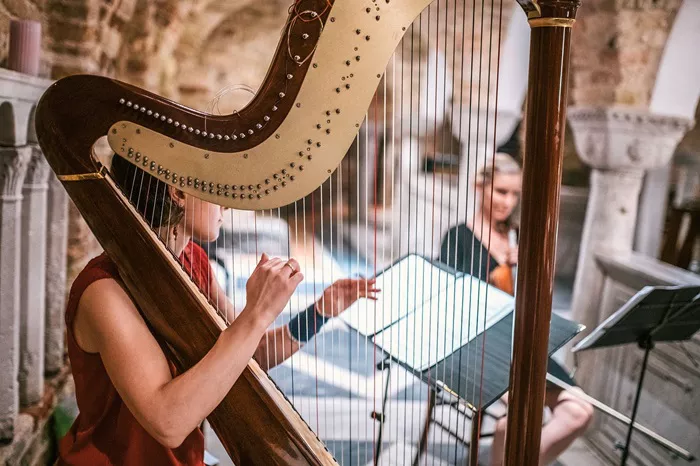Canon in D is one of the most iconic and recognizable classical pieces ever written. Composed by Johann Pachelbel in the late 17th century, it has a timeless charm that transcends genres and continues to be a favorite for weddings, events, and relaxation playlists. Although originally written for a string ensemble, Canon in D has been adapted for various instruments, with the harp version standing out as a uniquely enchanting rendition. This article delves into the history, structure, and appeal of Canon in D as performed on the harp, uncovering why this piece remains a beloved classic for centuries.
History of Canon in D
Pachelbel’s Life and Influence
Johann Pachelbel was a German Baroque composer known for his work in organ music. Born in 1653, he grew up in a period when music was evolving from the Renaissance to the Baroque style. Pachelbel became highly regarded for his contributions to both sacred and secular music, but it was Canon in D that would become his most famous piece, bringing him posthumous fame and enduring influence.
Composition and Discovery of Canon in D
Canon in D was likely composed sometime around 1680, though the exact date remains uncertain. It was not initially a widely known piece, as it only resurfaced in the 20th century. The piece became popular in the 1960s when it was recorded and released in modern arrangements, and it quickly gained fame for its soothing, repetitive melody. Canon in D now enjoys a firm place in popular culture, with adaptations in numerous genres and instrumentation.
The Journey to Harp Arrangements
While the original Canon in D was composed for a trio of violins and basso continuo, the beauty of the piece lies in its versatility. Over the years, it has been transcribed for various instruments, including piano, guitar, and harp. The harp arrangement, however, highlights the piece’s ethereal qualities, making it a popular choice for relaxation music and meditative listening.
Structure of Canon in D
The Canon Form
A canon is a musical form where a melody is imitated by other parts in a staggered manner, creating a rich, interwoven texture. In Canon in D, the main theme is introduced and repeated in a series of variations, with each variation building on the previous one. This structure gives the piece its hypnotic quality, as listeners become immersed in the evolving layers of sound.
Chord Progression and Melodic Lines
Canon in D is built on a simple chord progression that repeats throughout the piece: D, A, B minor, F# minor, G, D, G, A. This progression creates a sense of continuity, allowing for subtle variations that add depth to the music. The harp rendition captures these variations with grace, as the instrument’s natural resonance enhances the melodic lines.
Canon in D on Harp: A Unique Experience
The Harp’s Natural Elegance
The harp is known for its delicate, angelic sound, making it a perfect instrument for Canon in D. The piece’s repeated arpeggios and flowing melody resonate beautifully on the harp, bringing out an ethereal quality that is unmatched by other instruments. Each pluck of the strings echoes with warmth, amplifying the emotional depth of the piece.
Techniques for Playing Canon in D on Harp
Playing Canon in D on the harp requires a mastery of techniques such as arpeggios, glissandos, and finger independence. The piece’s repetitive structure means that harpists can experiment with dynamics and phrasing to bring out different emotions. Harpists often incorporate subtle variations in tempo and volume, adding a personal touch to each performance.
The Emotional Resonance of the Harp Arrangement
The harp rendition of Canon in D evokes a serene, almost meditative state in the listener. The gentle plucking of the strings creates a soothing backdrop, perfect for moments of reflection. This arrangement is often chosen for its ability to create an atmosphere of calm, making it ideal for weddings, yoga sessions, and even lullabies.
Canon in D’s Popularity in Modern Culture
Canon in D at Weddings and Celebrations
Canon in D is a staple at weddings, often chosen as the processional music for its romantic, uplifting qualities. The harp arrangement is particularly popular, as it adds a touch of elegance to the ceremony. The piece’s association with love and beauty has made it a timeless choice for couples around the world.
Canon in D in Film and Media
The piece has been featured in various films, television shows, and commercials, often used to evoke a sense of nostalgia or tranquility. Its familiar melody makes it instantly recognizable, and the harp version adds an extra layer of emotion that resonates with audiences.
Adaptations and Interpretations
Canon in D has been reimagined in countless ways, from orchestral renditions to electronic remixes. The harp version remains one of the most beloved interpretations, as it captures the purity and simplicity of the original composition. Many harpists have created their own unique versions of the piece, adding personal touches that reflect their individual style.
See Also: What Are the 4 Main Instrument Families in Classical Music?
Conclusion
Canon in D has captivated listeners for centuries, and its harp arrangement brings out the piece’s most delicate qualities. The timeless melody, paired with the harp’s enchanting sound, creates a listening experience that is both relaxing and profound. As a piece that has transcended its Baroque origins to become a modern classic, Canon in D continues to inspire musicians and listeners alike. Whether heard at a wedding, in a film, or during a quiet moment at home, Canon in D on the harp remains a testament to the enduring power of music to soothe the soul.
Related Topics
Decoding Andrea Bocelli’s Love in Portofino: A Deep Dive
Exploring Tchaikovsky’s No.1 Symphony and Its Lasting Legacy

